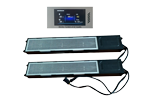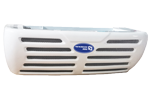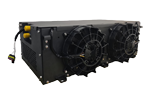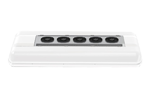By controlling the energization frequency and current size of each phase winding of the stator of the permanent magnet synchronous motor, the speed and torque of the motor rotor can be adjusted with high precision, and the speed of the compressor can be directly controlled to adjust the refrigerant displacement to suit the operation of the car. Different working conditions requirements for air conditioning systems.
What drives the air-conditioning compressor of new energy vehicles is a three-phase permanent magnet synchronous motor, and the power supply to the air-conditioning motor is three-phase high-voltage alternating current.
The high-voltage battery can only provide direct current. For this purpose, the direct current must be converted into alternating current. This task is undertaken by the frequency converter (ie, the power control unit), which generates AC power supply to the air conditioning compressor and the three-phase hydromagnetic synchronous motor. Three-phase permanent magnet synchronous motors are commonly used in electric vehicles. In particular, the power to drive the car is provided by the three-phase magnetic synchronous motor. It is very helpful for maintenance personnel to understand the characteristics of this motor for maintenance work.
Electric vehicles use different motors in different historical periods. The lower-cost DC motor was first used. However, it has shortcomings such as commutation sparks, limited speed under high loads, large size, and frequent need for maintenance. It cannot be used for closed air conditioning compression. The drive motor of the machine, and the three-phase permanent magnet synchronous motor has the characteristics of small size, light weight, high operating efficiency, energy saving, variable frequency speed regulation, extremely reliable operation, and low maintenance cost, so modern new energy vehicle air conditioner compression The preferred choice for the machine is a three-phase permanent magnet synchronous motor.
The three-phase permanent magnet synchronous motor is mainly composed of a stator and a rotor. The energized stator winding is used to generate a rotating magnetic field, which acts on the permanent magnet rotor to form magnetic force and rotate synchronously. The stator of the motor is supplied with three-phase alternating current, thereby generating a rotating magnetic field between the air gap between the stator and the rotor. No matter what the relative position of the stator's rotating magnetic field and the permanent magnet rotor is at the beginning, there will always be a magnetic field between the rotating magnetic poles of the stator and the magnetic poles of the rotor. The magnetic force drags the rotor to rotate synchronously. Since the rotor has magnetic poles and can rotate at extremely low frequencies, it has a wider speed regulation range than an asynchronous motor.









.png)






